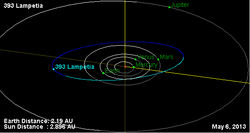Astronomy:393 Lampetia
From HandWiki
Short description: Main-belt asteroid
 Orbital diagram | |
| Discovery | |
|---|---|
| Discovered by | Max Wolf |
| Discovery date | 4 November 1894 |
| Designations | |
| (393) Lampetia | |
| Pronunciation | /læmˈpiːʃiə/[1][2] |
| Named after | Lampetia |
| 1894 BG | |
| Minor planet category | Main belt |
| Orbital characteristics[3] | |
| Epoch 31 July 2016 (JD 2457600.5) | |
| Uncertainty parameter 0 | |
| Observation arc | 112.56 yr (41112 d) |
| |{{{apsis}}}|helion}} | 3.6980 astronomical unit|AU (553.21 Gm) |
| |{{{apsis}}}|helion}} | 1.8568 AU (277.77 Gm) |
| 2.7774 AU (415.49 Gm) | |
| Eccentricity | 0.33146 |
| Orbital period | 4.63 yr (1690.6 d) (4.63 yr) |
| Mean anomaly | 173.245° |
| Mean motion | 0° 12m 46.584s / day |
| Inclination | 14.879° |
| Longitude of ascending node | 212.460° |
| |{{{apsis}}}|helion}} | 2023-Aug-15 |
| 90.824° | |
| Physical characteristics | |
| Dimensions | 96.89±31.4 km |
| Rotation period | 38.7 h (1.61 d)[3][4] |
| Geometric albedo | 0.0829±0.099 |
| Absolute magnitude (H) | 8.39 |
Lampetia (minor planet designation: 393 Lampetia) is a fairly large main belt asteroid that was discovered by German astronomer Max Wolf on 4 November 1894 in Heidelberg. It has an unusually low rotation rate, with a period estimated at 38.7 hours and a brightness variation of 0.14 in magnitude.[4]
In 2000, the asteroid was detected by radar from the Arecibo Observatory at a distance of 0.98 AU. The resulting data yielded an effective diameter of 125 ± 20 km.[5]
It comes to opposition at apparent magnitude 10.5 on 6 July 2023[6] and then perihelion on 15 August 2023.[3]
References
- ↑ James Knowles (1851) A Critical Pronouncing Dictionary of the English Language
- ↑ Joseph Thomas (1908) Universal Pronouncing Dictionary of Biography and Mythology
- ↑ 3.0 3.1 3.2 "393 Lampetia", JPL Small-Body Database Browser (NASA Jet Propulsion Laboratory), https://ssd.jpl.nasa.gov/tools/sbdb_lookup.html#/?sstr=393&view=OPC, retrieved 10 May 2016.
- ↑ 4.0 4.1 Scaltriti, F.; Zappala, V.; Schober, H. J. (January 1979), "The rotations of 128 Nemesis and 393 Lampetia - The longest known periods to date", Icarus 37: pp. 133–141, doi:10.1016/0019-1035(79)90121-0, Bibcode: 1979Icar...37..133S.
- ↑ Magri, Christopher et al. (January 2007), "A radar survey of main-belt asteroids: Arecibo observations of 55 objects during 1999 2003", Icarus 186 (1): 126–151, doi:10.1016/j.icarus.2006.08.018, Bibcode: 2007Icar..186..126M, http://echo.jpl.nasa.gov/asteroids/MBAs/magri.etal.2007.mbas.pdf, retrieved 2015-04-14.
- ↑ JPL Horizons (Opposition)
External links
- 393 Lampetia at AstDyS-2, Asteroids—Dynamic Site
- 393 Lampetia at the JPL Small-Body Database
 |

